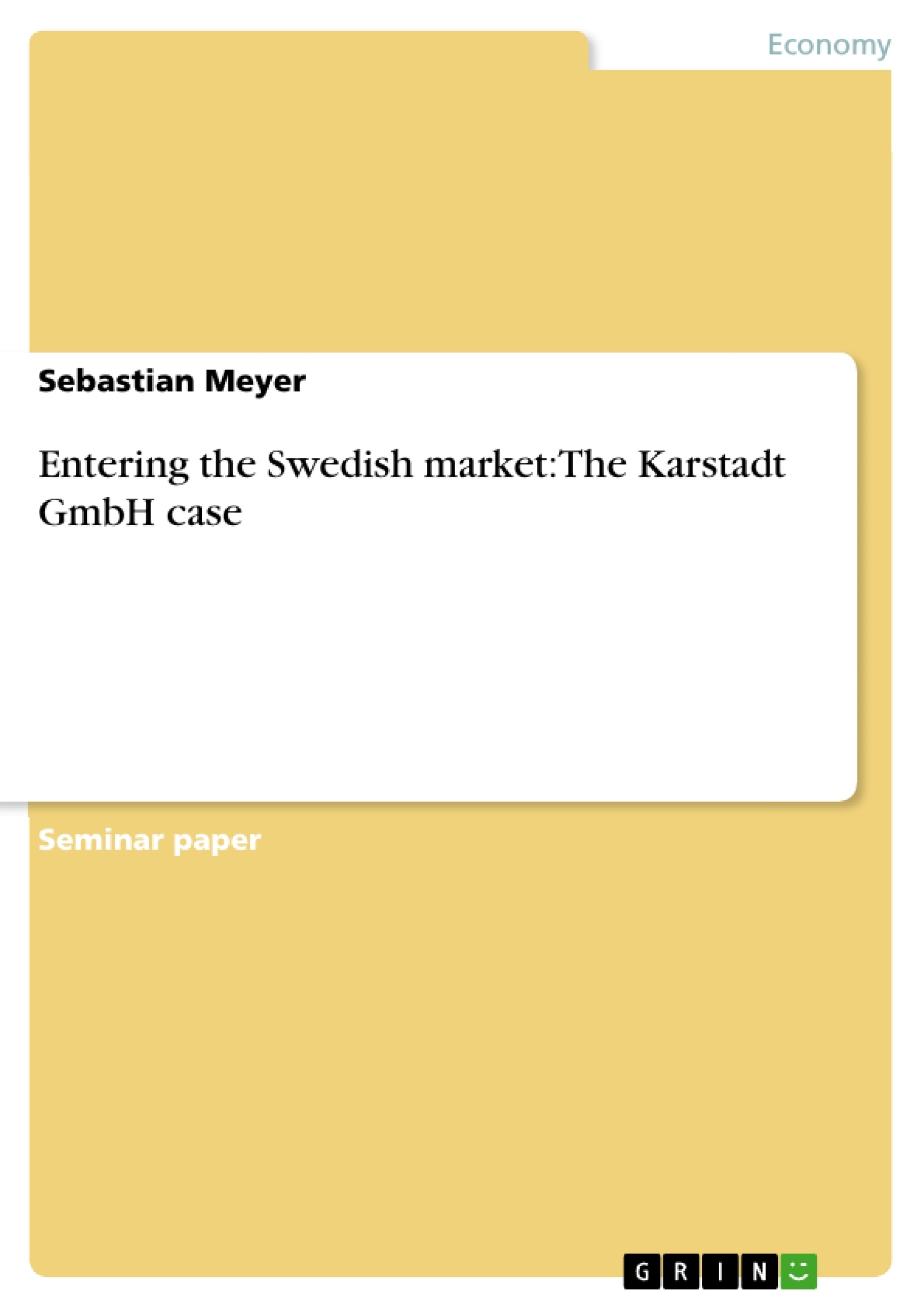As one of Europe’s oldest and largest over-the-counter retailers Karstadt GmbH, subsidiary of Karstadt Quelle AG (Figure 1), operates exclusively in Germany. The present assignment puts forward the proposal that Karstadt GmbH should attempt to penetrate the Swedish market. Furthermore, a PEST analysis and a risk assessment as well as a market entry plan and a final conclusion will form different parts of this work
Inhaltsverzeichnis (Table of Contents)
- Introduction
- Information about the Company
- Scenario and Product/Services
- PEST Analysis
- Political factors
- Economic factors
- Sociocultural factors
- Technological factors
- Risk Assessment
- Market Entry Plan
- Market Entry Strategy
- Corporate and strategic marketing objectives
- Market to be entered
- Market Entry Alternatives
- Operational Plan
- Detailed Target Market Analysis
- Demography
- Geography
- Psychography
- Market Positioning Statement
- Product
- Price
- Place
- Promotion
- Management Implications
- People
- Profits
- Physical Evidence
- Monitoring, Controls, Budget
- Measurements
- Control Systems
- Budget
Zielsetzung und Themenschwerpunkte (Objectives and Key Themes)
This assignment proposes the expansion of Karstadt GmbH, a subsidiary of KarstadtQuelle AG, into the Swedish market. It aims to conduct a thorough analysis of the Swedish market through a PEST analysis and a risk assessment, ultimately developing a comprehensive market entry plan. The objectives include analyzing the political, economic, social, and technological factors influencing the Swedish market, identifying and mitigating potential risks, and outlining a strategic approach to enter the market.
- Market entry strategy
- Risk assessment
- PEST analysis
- Target market analysis
- Operational plan
Zusammenfassung der Kapitel (Chapter Summaries)
The introduction provides an overview of Karstadt GmbH and its parent company, KarstadtQuelle AG, outlining their size and scope within the European retail market. It establishes the context for the assignment by highlighting the challenging economic conditions in Germany and the strategic decision to enter the Swedish market. The focus of the entry will be on establishing department stores in prime city centre locations.
The PEST analysis examines the political, economic, social, and technological factors influencing the Swedish market. It analyzes the political landscape, including government policies and regulations, the economic climate, the cultural and social environment, and the technological advancements shaping consumer behavior and retail trends in Sweden.
The risk assessment chapter explores the potential risks associated with entering the Swedish market. This section will evaluate various factors such as competition, regulatory hurdles, and consumer acceptance of the brand, assessing their impact on the success of the market entry.
The market entry plan details the strategic approach for entering the Swedish market. It outlines the overall strategy, defines corporate and marketing objectives, identifies the target market, and evaluates various market entry alternatives. This section will provide a clear roadmap for the company's foray into the Swedish market.
The operational plan delves into the specifics of executing the market entry strategy. This chapter includes a detailed analysis of the target market, considering demographics, geographic factors, and psychographic profiles. It also outlines the market positioning statement, addressing product, price, place, and promotion strategies.
The management implications chapter focuses on the key operational considerations for successful implementation. It examines the management of people, profit maximization, and the role of physical evidence in the customer experience.
Finally, the monitoring, controls, and budget section outlines the mechanisms for tracking the performance of the market entry strategy. This chapter discusses measurement metrics, control systems, and the financial budget allocated to the project.
Schlüsselwörter (Keywords)
The assignment focuses on the entry of a European retail giant, Karstadt GmbH, into the Swedish market. Key themes include market entry strategies, PEST analysis, risk assessment, target market analysis, operational planning, and management implications. The assignment considers the economic climate, consumer behavior, competition, and various other factors influencing market entry success.
- Citar trabajo
- B.A. Sebastian Meyer (Autor), 2004, Entering the Swedish market: The Karstadt GmbH case, Múnich, GRIN Verlag, https://www.grin.com/document/75509



